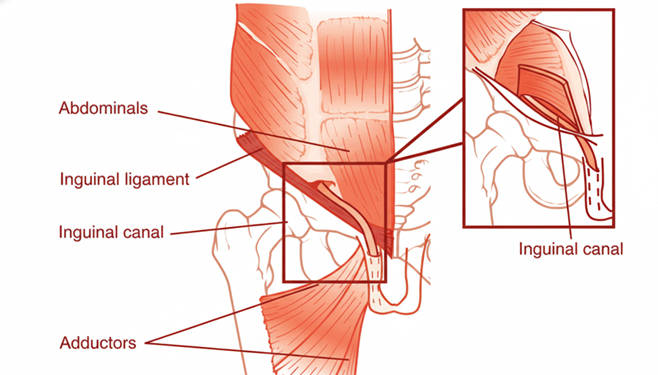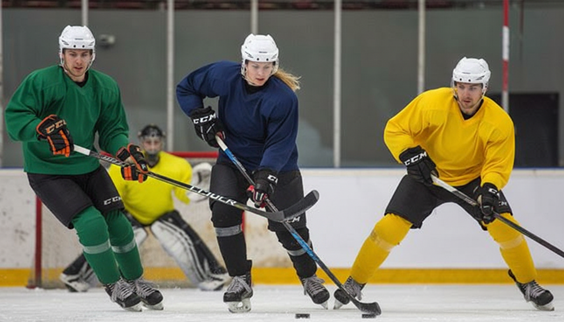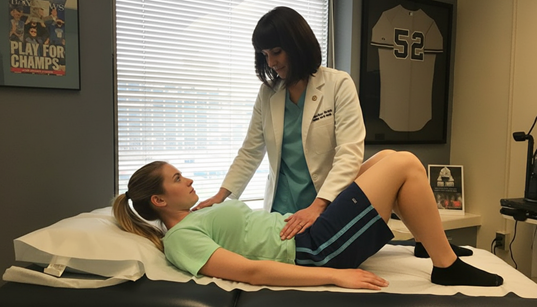A sports hernia, which is also known as athletic pubalgia is a frequent injury that affects athletes, especially those who participate in sports that require rapid directions or a lot of twisting movements. While it is similar to the traditional inguinal hernia the sports hernia is different and is primarily a result of the tear or strain of abdominal soft tissue, or the groin.
What is a Sports Hernia?
Contrary to an inguinal hernia that is when a part of the intestine presses against the abdominal wall the sports hernia will not cause an apparent bulge of the groin. It is instead caused by the strain or tear in the muscles, tendons or ligaments that are located in the groin or abdominal area. The most common cause is that the oblique muscles located in the abdomen area are involved, and in particular the tendons that connect these muscles to pubic bone. The injury can also affect the tendons that connect the muscles of the thigh with the bone pubis.
The Anatomy of a Sports Hernia

The soft tissues most often damaged during a sports hernia include the oblique muscles, as well as the tendons linking those muscles with the pubic bone. The adductors which are the muscles that bring leg bones together are usually affected by the injuries as well. The tendons, when stretched too much or strained, can cause the pain and discomfort common to a hernia in sports.
Causes of Sports Hernia

A sports hernia is frequently caused by activities that involve abrupt changes in direction or sudden, violent twisting motions. Football, soccer wrestling, as well as the game of ice hockey are particularly prone to injuries of this kind. Any activity that puts strain on the muscles or tendons of the abdomen area or the groin region like sprinting or pivoting, could cause a hernia in sports.
Symptoms of Sports Hernia
The signs of a sporting hernia typically manifest as intense discomfort in the groin at the time of injury. Contrary to conventional hernias which result in a visible bulge however, a sports hernia will not display any visible signs such as a lump. The pain caused by the hernia of sports usually improves when resting, but it can get worse when the patient returns to physical activity, particularly moves that involve twisting or sudden directions. If left untreated, a sporting hernia can lead to the development of a typical inguinal hernia. A apparent bulge could appear when the abdominal organs push against weak soft tissues.
Diagnosing a Sports Hernia

To identify a hernia in sports doctors first talk about the symptoms you are experiencing and the cause of the injury. When conducting a physical examination the doctor may look for tenderness in the pubis or groin area. But, unlike an inguinal hernia hernia might not be visible in this test. Your doctor could also run certain tests, for example the requirement to sit-ups or stretch your trunk to resist. These exercises typically cause discomfort if a hernia in the sports is present.
In certain cases imaging tests, such as X-rays and MRIs can be used for confirmation of the diagnoses or rule out possible causes for discomfort. Bone scans may be recommended to further clarify the issue.
Treatment Options for Sports Hernia
Non-Surgical Treatment
Most cases of hernias in sports can be treated with surgery, particularly in the initial stages. Treatment for immediate symptoms usually consists of the application of an ice pack to relieve swelling and pain. For the first 7-10 days following injuries, wraps of compression could assist in relieving symptoms, especially in the event of a visible bulge.
After the acute pain has subsided it is common for physical therapy to begin within two weeks. The focus of physical therapy is on strengthening abdominal and thigh muscles to increase flexibility and speed the recovery. Non-steroidal anti-inflammatory medications (NSAIDs) include naproxen and ibuprofen can help to lessen pain and swelling.
With the right physical therapy A lot of athletes can resume their sporting activities within about 4 to 6 weeks. If the injury persists even after activities resume, then surgery could be thought of.
Surgical Treatment
If non-surgical treatments do not provide relief or the pain becomes too severe surgical intervention may be needed in order to repair the damaged tissues. The surgical options are:
- Conventional Open Surgery: This involves an additional incision to get access to the site of injury.
- Endoscopic surgery: The minimally-invasive procedure involves small incisions as well as cameras to aid the surgeon through the repair of the damage.
Both approaches produce similar results. In certain instances surgeons might conduct an inguinal neurectomy. which is a procedure that cuts the nerve that runs through the groin area to relieve the pain that persists.
Post-Surgery Rehabilitation
Recovery following surgery usually is between 6 and twelve weeks. the majority of athletes returning to their sport after rehabilitation. The doctor will give you an individual rehabilitation program to help you recover the strength and endurance.
In some cases, further procedure may be required when the pain persists in the thigh’s interior following the initial surgery. A tenotomy of the adductor can be done, in which the tendon connecting the muscles of the inner thigh with the pubis muscle is sliced in order to reduce tension and increase flexibility.
Outcomes and Recovery
Following surgical or non-surgical treatment and surgery, more than 99 percent of patients are able to return to their sporting activities. But, there is an opportunity that the injury will recur especially for athletes who work their bodies with a lot of force during high-impact sports. A few athletes may require additional treatment if the injury occurs again or they continue to experience pain following their initial treatment.
Conclusion
A sports hernia can be an injury that is painful and affects athletes playing high-intensity sport. While it’s not likely to present with an obvious bulge, as a typical inguinal hernia it causes can be long-lasting and severe when not properly treated. A timely diagnosis, exercise, physical therapy and surgical procedures when needed can aid athletes in recovering and resume their sports activities.
If you suspect that you’ve got a hernia in your sports, consult with a medical professional to determine the exact diagnosis and a customized treatment strategy. Careful and attentive the healing process will ensure you’re back playing with no long-term problems.




